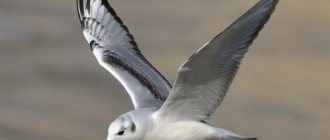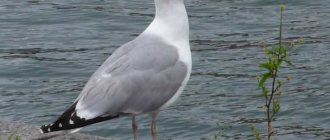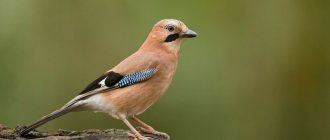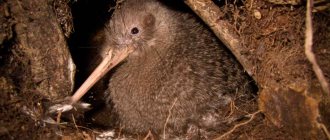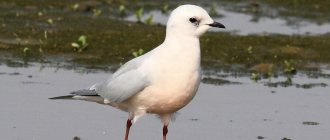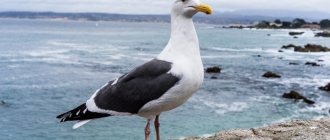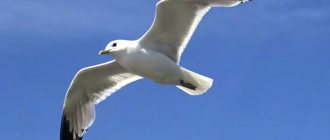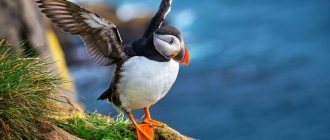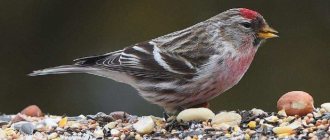Nutrition
What makes these birds unsurpassed hunters is their evenly pointed, thin beak, which allows them to catch any prey, even slippery and sticky ones. The main part of their diet is small fish and squid. Often the gull bird feasts on the remains of prey from predators larger than itself, circling close to schools of dolphins, whales and other sea predators.
In search of food, these birds make endless circles over the water, boldly fly considerable distances from the coastline, constantly observing what is happening in shallow waters.
In this way, they track down schools of fish, which, rising to the upper layers of the ocean, often become easy prey for hungry gulls. But when hunting for their victims, seagulls do not know how to dive to significant depths.
These birds often look for food along the coastline, going in search of the carcasses of fur seals and seals. They pick up dead shellfish, starfish, crabs, and other representatives of ocean fauna. Species that live in the steppe near water bodies and beyond the Arctic Circle are often content with plants and berries, catching voles and mice, and a variety of insects.
It just so happens that on planet Earth today there is enough food for such birds. And the abundance of food supply is associated with human life. Oddly enough, this time, people are helping the survival of these birds, and not contributing to the destruction of these bird species.
It is precisely because of the abundance of food near human settlements that seagulls have been accustomed since ancient times to settle close to the signs of civilization. They tend to move to ports and beaches, where they look for tasty morsels - leftover food from people. Birds often do not hesitate to feast on waste in city landfills.
What does it eat?
Seagulls eat a wide variety of foods; if necessary, they can easily switch from one type of diet to another. In coastal regions, gulls hunt and catch fish, crustaceans, mollusks, echinoderms, and aquatic worms in the sea. In search of prey, they first look for it near the surface of the water, without diving completely, but only lowering their head or part of their body into the water. Occasionally, birds may circle above the water in search of food. If the prey of a seagull is an animal covered with a shell or shell (a mollusk or crustacean), then the bird lifts it into the air and throws it onto the stones from a great height to break the hard shell. Seagulls also readily feed on waste near fishing vessels and enterprises that process seafood products. On land, gulls consume both plant and animal food (rodents, lizards, chicks and eggs of other bird species, insects and their larvae, berries, grain). They can eat carrion and food waste. In addition, gulls can destroy other people's nests and take prey from other bird species, for example, terns, cormorants, skuas, puffins, and ducks.
Reproduction and lifespan
Married couples of these birds do not break up during their lives, and each of the partners remains faithful to the other, content with the company of their only one until death. However, in the event of the death of the chosen one, there is usually another roommate.
The mating season for seagulls occurs once a year. The courtship of birds before mating consists of making certain, rather complex movements of the head, body and entire plumage. Such rituals are usually accompanied by vocal signals.
The cry of a seagull in such cases resembles a meow. Immediately before intercourse, the partner brings his lady a treat, which serves as confirmation of the good relationship in this married couple.
Seagulls begin building their nests between April and June. Cozy houses for chicks can be located on narrow ledges, right on the grass or even on the sand. The material for construction is selected depending on the type of terrain.
Marine species of gulls pick up wood chips and shells. In the Arctic Circle, birds usually use reeds, dry algae, and grass. A mother seagull lays up to three colorful eggs at a time. Then she spends a month (or a slightly shorter period of time) incubating the offspring. And a caring male provides his partner with food in abundance.
Soon the chicks are born. They do not hatch all together, but usually at intervals of one or two days. The offspring of seagulls, covered with thick down, are unusually viable from the very first hours of life, and also have developed visual organs.
Laying seagull eggs in a nest
True, newborn chicks lack the ability to move independently, but not for long. Only a few days pass and the new generation is already embarking on its journey through the bird colony.
The struggle for existence among the chicks is quite fierce, and parents, as a rule, give preference to the older ones. Therefore, it happens that with a lack of food, the youngest gull cubs die.
The down of chicks is an unusually successful camouflage for them, saving them in case of danger. Because of this, small creatures become inconspicuous against the background of sea stones and sand.
Seagull chicks have plumage that makes it easier for them to camouflage themselves.
Young individuals find their own pair for procreation at the age of one or three. Such birds live in nature, if unexpected death does not overtake them earlier, for about twenty years. However, the lifespan of such birds on earth largely depends on the variety. For example, individuals of herring gulls have a good chance of living up to 49 years.
It should be noted that recently many have begun to consider these birds harmful, posing a significant threat to the entire ecosystem. It's all about the decrease in the number of fish in the planet's oceans, which has become especially noticeable in recent decades.
The consequence of such a hasty decision by greedy and selfish representatives of the human race is the mass destruction of these beautiful winged creatures in many regions.
However, when forming an opinion about them, it is necessary to take into account the benefits of such birds. By eating the corpses of living beings and leftover food, they thus fight for the ecological purity of the surrounding space.
Food
The habitat of seagulls is quite widespread - they can be seen not only soaring over sea or ocean spaces. Birds settle near rivers and fresh water reservoirs. They are found in the tundra and desert, they can be seen even in densely populated areas of cities. No matter what continent birds settle on, there must be a body of water nearby. The main criterion for choosing a place is the opportunity to profit from something.
The main source of food for seagulls remains the inhabitants of the sea (fish, squid, starfish). But birds do not shun “worldly food”, picking up human waste. They look for remains of animal food in garbage dumps on the beach and garbage containers near residential buildings.
Life at the Zoo
At the Moscow Zoo, herring gulls live in enclosures with a swimming pool in the Bird House. Their diet is identical to that of the black-headed gull and consists of a mixture of animal and plant foods.
But the zoo also has free-living herring gulls, which have settled on the Great Pond of the Old Territory. They first appeared here in 2011, apparently moving to us from the Moscow River. Then there was only 1 pair, however, every year the colony grew larger and now at least 7 pairs nest, and there are also single birds. Even during the reconstruction of the Big Pond, when the water was drained from it, the seagulls did not leave the territory they liked, being content with the small remaining puddles. They breed regularly, raising several chicks annually. The seagulls feed here on the pond; in the summer these are fish - carps living in the pond, and chicks of waterfowl (mallards, goldeneyes and some others), and in the winter - pigeons, which they catch on the shore. The seagulls have become so comfortable on the pond and behave so actively and economically that even crows cannot compete with them in obtaining food. Along with the gulls, this colony is also inhabited by common terns (Sterna hirundo), smaller representatives of the gull family. By the way, it was they who founded this free colony on the Bolshoi Pond, settling here in 2010. They continue to nest even now, despite such aggressive neighbors as herring gulls.
Social behavior
The herring gull is a colonial bird. Colonies can be very numerous (several hundred pairs), or they can be smaller; may be monospecific, i.e. Only herring gulls live in them, but they can be mixed, i.e. with other types of seagulls. Inside the colony, each pair has its own individual area, which it vigilantly guards. If in relation to an external enemy all the gulls in the colony behave very amicably, collectively repelling the attack, then neighboring pairs often quarrel among themselves, or even simply attack each other.
The behavior of gulls within a pair is also very complex, especially during the mating season. There is courtship on the ground, ritual feeding of the female by the male, and “chickling” behavior of the female (sitting near the nest, the female squeaks in a thin voice and begs for food from the male). After laying eggs, this mating behavior gradually subsides and then stops completely.
Interesting facts about the bird
- Seagulls can steal prey and eat the eggs of other birds. They even attack the chicks of other gulls.
- The smallest representative of the family is the small gull, whose weight is only 100-150 g, and the largest sea gull reaches a mass of 2 kg.
- Seagulls lead a colonial lifestyle. In their large colonies, the voices of birds are constantly heard, which resemble laughter, clucking, or even the screams of an angry cat.
- Hitchcock, in his film The Birds, depicted American herring gulls as winged pursuers of people. And this is not fiction. As a result of attacks by herring gulls on people who accidentally entered the territory of their colonies, the latter received head injuries, which even led to death.
- In former times, sailors determined the future weather by the behavior of seagulls: if seagulls sat on the masts of a ship or on the water, then this foreshadowed good weather, and if they wandered along the shallows or coastal rocks and screamed shrilly, it meant that a storm was approaching.
Distribution area
The herring gull gravitates to cold regions. She inhabits the Northern Hemisphere. During the winter months, these birds move to Florida, southern China, Japan and the Gulf . For nesting they chose the UK, Scandinavia and Iceland. They can also be seen on the islands of the Arctic Ocean, Canada, Alaska and the eastern shores of the United States.
Since the herring gull is highly dependent on aquatic food, it settles in coastal areas. It lives in mountains, cliffs, rocks, and sometimes in swampy areas. This bird has perfectly adapted to coexistence with people, so it often settles on the roofs of houses.
Conservation status
Throughout most of its extensive range, herring gull numbers are high and stable and do not require any special conservation measures. The global population of herring gulls numbers approximately 1 million pairs. However, in some places where the number and distribution of the species are limited for one reason or another, this gull is included in the regional Red Books. Thus, in many European countries, herring gulls of the European subspecies are protected, since their numbers there have decreased by almost 50% over the past 25 years. In Russia, for example, it is included in the Red Book of the Nizhny Novgorod region.
Types of seagulls
It is assumed that the ancient ancestors of these representatives of the bird kingdom were terns, blotches, waders and cutwaters. These are all birds that look like seagulls . For example, terns have many similarities with the described winged creatures and are also famous for their tirelessness in flight.
In total, scientists number about sixty species of seagulls. Although it is difficult to accurately classify these birds due to the tendency for interspecific crossing.
Naturally, for this reason, representatives of new generations of gulls are endowed with the characteristic features of two parental varieties at once. Next, the hybrids are crossed again and inherit the characteristics of more and more new species.
All of them have striking distinctive appearance features and rare properties, although in essence they are largely similar. Among the existing ones, the following interesting varieties can be distinguished.
- The herring gull is a fairly large specimen among its relatives. The body length in some cases reaches 67 cm, weight – up to one and a half kilograms. The powerful physique of these birds is impressive.
The head, which looks a little angular, is white in summer, and in winter it is covered with a characteristic motley pattern. The pattern at the end of the wing has also changed. The birds have a powerful beak and an impudent expression in their eyes. Most often, these creatures are found on sea coasts, but also take root near lakes, rivers and swamps with other waterfowl.
The herring gull has the plumage we are familiar with
- Large sea gulls are distinguished by a characteristic red spot on the mandible of the usually yellow beak. The top of the body of such winged creatures is dark, the bottom is white. The wing, dark on the outside, is bordered at the edges with light.
The young are distinguished by their brownish plumage with a pattern of stripes and spots. Fully-formed individuals are often compared to impressive black whales, and they look a lot like them. This is really a big seagull . Such birds are found on European and North American ocean coasts, often on rocky islands.
A distinctive feature of a large gull is the presence of a red spot on its beak
- The glaucous gull is like a smaller copy of the silver gull, but its appearance is more elegant: long wings, a rounded head, and a thin beak. Feather color undergoes seasonal changes. Body length reaches 46 cm.
The voice of such gulls is more monotonous and quieter than that of the herring gull. The sounds produced are similar to frequently repeated “cues”.
- the black-headed gull is a fairly small specimen. In summer, the plumage on the head of such birds is brown (in winter, this shade mostly disappears), and there are white circles around the eyes.
At the end of the wings there is a characteristic, very noticeable pattern. This variety is widespread throughout the European continent.
Black-headed gulls have black head plumage
- The black-headed gull is larger than the black-headed gull, although in appearance there are enough similarities with this relative. Adults are distinguished by white flight feathers.
This black-headed gull is present throughout the summer, but with the onset of cold weather its color changes. There are many such birds in the north of the Black Sea region and in Turkey. Their colonies are found in the west and central regions of Europe.
- The pink gull is a rare species, but very beautiful. The plumage of such birds is monochromatic and soft pink, which is simply a magical sight. Photos of such creatures are especially fascinating.
The beak and paws of this species of birds can be yellow, red or black. The winter feather plumage is unusually beautiful, but in the spring this spectacle may not be so impressive due to molting. It should be noted that the motley plumage of young individuals has a brownish tint.
The photo shows a pink seagull
- The white gull is a small circumpolar bird. The body length is only 45 cm. It lives in Arctic latitudes, as well as in regions of the north with similar climates. Lives in colonies and nests in rocks.
This seagull is white in feather color. It feeds on carrion and invertebrates. The excrement of polar bears, walruses and seals is quite suitable as food for such creatures.
White gull inhabitant of the Arctic regions
- The black-headed gull is a very remarkable species. Firstly, because this specimen is of impressive size. Birds are capable of reaching an average length of 70 cm. At the same time, their weight can reach 2 kg or more.
Secondly, this species is very rare. In addition, the appearance of the creatures described is very interesting. As the name suggests, the bird's head is black . A seagull of this variety also boasts a brilliant shade of feathers in this area.
The beak is yellow with a red tip. The main background of the body is white, the wings are gray, the paws are yellow. Such birds deserve their name for the characteristic sounds they make, which are multiple “ay”.
Black-headed Laughing Gull
- The gray gull is of medium size in comparison with its relatives. It is found in the western regions of South America, settling along the Pacific coast. The plumage of the birds is lead-gray. They have black legs and beak.
You can distinguish a gray gull not only by its plumage, but also by its black legs and beak.
Lifestyle and habitat
Seagulls are found throughout the planet, where there are bodies of water suitable for such birds. However, some species of these birds prefer exclusively temperate latitudes, while others prefer the tropical zone. Some types of gulls are found along the coasts of vast seas and vast oceans.
They tend to live sedentary lives. The rest of the species choose lakes and rivers and inhabit desert oases. These types of birds most often migrate during unfavorable seasons, preferring to move to the warm sea corners of the globe. But some colonies of birds remain in their usual places of existence: in areas of large cities, where they feed on food waste.
These birds are simply excellent flyers. All this is facilitated by the peculiarities of their structure, in particular the shape of the wings and tail. In the air they feel like they are in a cozy home. Such birds are able to fly tirelessly and move record distances.
Birds are also known for their pirouettes, maneuvers and stunts during flight. These birds have webbed feet that allow them to swim beautifully. A seagull moves quickly on water, just as it runs on land.
These winged creatures, like most waterfowl, form flocks. Their colonies can be a huge community and include several thousand individuals, but there are also very small groups, the number of members of which is one or two dozen.
Looking at the seagulls soaring above the sea wave, striking with their beauty and tranquility, many feel a surge of romantic inspiration. However, the satisfied appearance of the bird testifies more to the abundance of food in those regions of prosperity where it hunts and lives.
But if there is not enough food, these birds very soon take on the guise of greedy and daring predators, capable of fighting for a piece of food with incredible aggressiveness not only with adult relatives from the flock members, but even with fledgling chicks.
But when danger arises, these creatures instantly unite together to fight together against a common enemy. And it could be a fox, a bear, an arctic fox, among birds - a raven, a falcon, a kite, or a person who encroaches on their life.
They unite in flocks of seagulls while hunting, as well as fighting off threats
To prevent enemy attacks and protect themselves, seagulls have a wonderful and well-functioning warning system.
